Physical Tour

Front
The front of the Canon PowerShot SX10 IS is dominated by the large fixed lens, which projects out of the body several inches even when fully retracted. The 20x optical zoom lens boasts a focal length of 5.0-100mm and an aperture of f/2.8 - f/5.7. Just above the lens sits the pop-up flash. Between the flash and the lens are left and right microphones for stereo video recording. Just above and to the right of the lens is the auto focus assist lamp. The left side of the front is dominated by the hand grip, which also juts out from the main body of the camera.
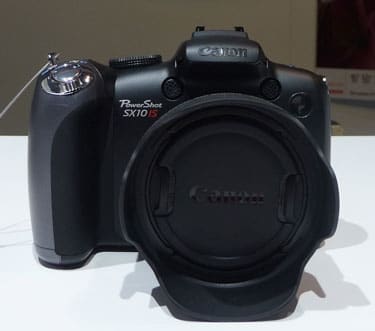
The front is dominated by the 20x optical zoom lens.
Back
On the back most of the space is dominated by the LCD, which was disappointingly small at only 2.5 inches in size. The LCD can be folded out and rotated. Above and to the left of the lens is a shortcut key that can be assigned to a function of your choice. During playback this doubles as the Print button. Directly above the LCD is the digital viewfinder. To the right sits a dedicated Record button for video capture.
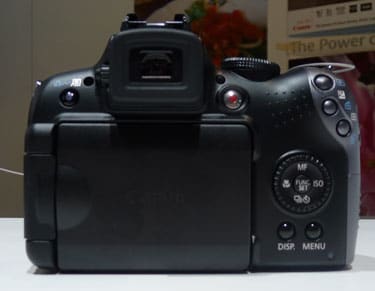
The back doesn't have as many buttons and dials as you might expect.
To the right of the LCD are the main controls, a 4-way surrounded by a rotating dial. The 4-way gives you quick access to Manual Focus (up), Macro (left), ISO (right) and Burst Mode or Self-timer (down). Pressing in on the center select button will give you the Function Set menu, while the dial provides different setting controls depending on your current mode and menu selection. Below the 4-way sit the Display and Menu buttons.
At the top right of the back are three buttons that are easily reached with your right hand when holding the camera. From the top these are Play, Exposure Compensation and AF Frame Selector. The latter two double up as Erase and Jump buttons when in playback mode.
Sides*
*The left side of the Canon PowerShot SX10 IS has an eyelet at the top to run one side of a neck strap through. This eyelet is mirrored on the right side. The only other feature on the left side is a speaker for video playback.

From the left side you can see how far the lens extends.**

*The right side shows the grip that your right hand will wrap around.
*
The top of the Canon PowerShot SX10 IS doesn't have as many dials as the Canon G10 does, and is slightly different than the SX5. At the far left there is a lonely Flash/Microphone button. To the right is the hot shoe for adding your own flash. To the right of that is the mode dial. Sitting on the hand grip at the far right are the On/Off button near the back and the Shutter button with associated Zoom toggle near the front.
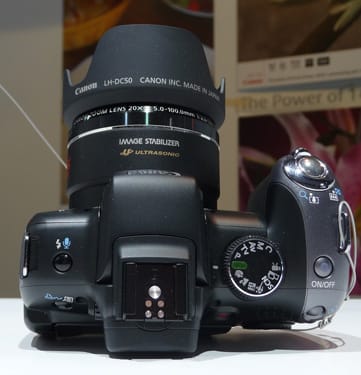
The hot shoe for an external flash is on top.
All you'll find on the bottom of the Canon PowerShot SX10 IS are the tripod mount and the battery cover, which has a release switch.
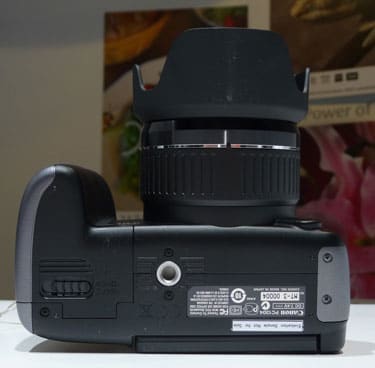
Battery door and tripod mount are the only things on the bottom.
Components
Viewfinder
The electronic viewfinder sits just above the LCD. It's nicely padded with soft plastic and is large enough that even those with long eyelashes should feel comfortable with it. The Display button toggle the view between the viewfinder and the LCD screen. There are two information display options for the electronic viewfinder, a relatively clean version or one overlaid with all the information you would get on the LCD, including a live histogram.

The digital viewfinder is nicely cushioned.
LCD Screen
The 2.5-inch LCD on the Canon PowerShot G10 is significantly smaller than the three-inch displays we're seeing on many high end point-and-shoot cameras and is unchanged from the SX5 IS. The combination of small size and mediocre 230,000-pixel resolution point to an area where we think Canon could have done better. We do like the way the display is mounted, though. The ability to pivot and swing the screen makes shots of unusual angles possible without a lot of bending, squatting or stretching, three of our least favorite things.

The LCD is small at only 2.5 inches diagonal.
**
Flash
The pop-up flash is located just above the lens on the front of the camera. You can open the flash with your hand or leave it on automatic, in which case it will pop up when needed when using automated shooting modes. The substantial height of the flash above the lens helps to reduce red-eye, a problem that smaller point-and-shoots with their flash right next to the lens frequently suffer from. In the Function Set menu of the SX10 IS you'll find an option to control the output intensity of the flash, a nice feature that we don't see very often.
**

The relatively high flash position helps minimize red-eye.
Lens
The most prominent feature on the Canon PowerShot SX10 IS is the 20x optical zoom lens. With a focal length of 5.0-100mm f/2.8-5.7 it's a step up from the lens found on the SX5 IS. The lens is a good fit for amateur nature photographers, peeping Toms and others who want to get close to their subject without getting too close.
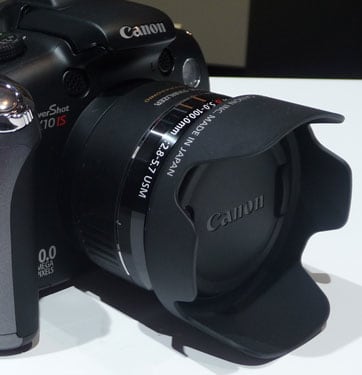
The lens extends out even further when you start using the 20x optical zoom.
Connections
The Canon PowerShot SX10 IS's connections are fairly standard. On the right side you'll find two tethered plastic covers near the top. On the top, just below the neck strap tether you'll find the cover for the AC in and A/V out. On the left and slightly below that is a separate cover for the mini USB port. We're not sure why Canon didn't just go with a single cover for all three ports.


*We're not sure why two separate compartments
were necessary for these three ports.*
Battery
The Canon PowerShot SX10 IS takes four standard AA batteries. The battery bay is found on the bottom of the device and has a secure switch to open and close it. According to Canon four alkaline batteries will get you through approximately 340 shots, while nickel-metal hydride batteries will let you take around 600 shots.

The Canon PowerShot SX10 IS takes four AA batteries.**Memory**
The Canon PowerShot SX10 IS supports SD cards, including high capacity SDHC cards up to 32GB. The memory card slot is found on the right side of the camera, inside it's own door.

The SX10 IS takes SDHC cards, currently available up to 32GB.
Design / Layout
Model Design / Appearance
The Canon PowerShot SX10 IS is a consumer-oriented camera, and the relatively curved lines of the device reflect that orientation. Styled in a matte black the SX10 IS is most definitely not for those looking to slip a small point-and-shoot into a pocket. Instead, the large lens and hand grip are more reminiscent of an SLR.
Size and Handling
The Canon PowerShot SX10 IS is a substantial camera. Measuring 4.88 x 3.48 x 3.42 inches (124.0 x 88.3 x 86.9mm) this is definitely one of the larger non-SLR cameras you'll find. Still, the all-plastic construction does help hold down the weight a bit at 19.8 ounces (560g); given how bulky the camera is you'd expect it to weigh more. Speaking of expectations, you should expect to be carrying this camera around in a bag or on a shoulder strap.

*

-
*The Canon PowerShot SX10 IS is large for a point-and-shoot,
but not quite up to SLR dimensions.*
When held in the hand the surprisingly light SX10 IS fits comfortably in your right hand. This is aided by the nicely curved hand grip, although we would have liked to see some more texturing or padding on the grip rather than a slick plastic surface. In this position the thumb of your right hand will sit right above the Play, Exposure Compensation and AF Frame Selector buttons. You will need to shift a little to get to the 4-way control further down, especially those with smaller hands.
Menu
As with other Canon cameras the SX10 IS has two menu modes. The Function Set menu can be accessed by pressing the center select button of the 4-way. From here you can make quick adjustments to a familiar array of options including white balance, My Colors, Bracketing, Flash, Video Quality and Photo Size. Interestingly there's no option here for photo quality.

*The main menu offers a tabbed interface with
a customizable Favorites tab.*
The main menu can be accessed by pressing the Menu button below the 4-way, which brings up a tabbed interface that will also be familiar to Canon users. The plethora of options available here are somewhat alleviated by the customizable fourth tab that allows you to add our own commonly used options.
Ease of Use
The Canon PowerShot SX10 IS is a mixed bag in terms of ease of use. It's definitely a camera aimed at the high-end amateur photographer, with a variety of manual controls and options. That said it's easy enough to throw the camera into Automatic mode and just shoot to your hearts content without worrying yourself over things like ISO, aperture and shutter speed.
For more advanced photographers we found the SX10 IS is not as easy to use as a camera like the Canon G10, which has more dials and buttons for one-click access to important features like ISO and Exposure Compensation. Sophisticated photographers might find navigating a menu to change the metering mode, for example, an annoyance.
Modes
Auto Mode**
In Auto mode the Canon PowerShot SX10 IS does almost all the work. In the Function Set menu all you can change is the image size option, and your only ISO options are Auto and HI. This is even more idiot-proof than the Canon G10, and is indicative of the fact that the SX10 IS is more consumer oriented than that device.
Movie Mode
The Canon PowerShot SX10 IS can capture video at a maximum resolution of 640 x 480 and 30fps. This is run of the mill for a consumer point-and-shoot, and we're a little disappointed that no HD or widescreen options are available given the SX10 is at the high end of Canon's consumer lineup.
During video capture you can change the White Balance and use the My Colors feature (see below) from the Function Set menu . There are no metering mode options available and instead of true Exposure Compensation you get a Brightness setting.
Drive / Burst Mode**
Pressing down on the 4-way will bring up your burst mode settings. Your options here are Continuous and Continuous Auto Focus. According to Canon you can get 1.4 fps on the former and 0.7 fps on the latter, neither of which will get anyone's pulse racing.
Playback Mode
Hitting the Play button at the top right of the back will put you into playback mode. From here you can switch to the next or previous image/video by using left/right on the 4-way control. You can also use the rotating dial around the 4-way to quickly scroll through thumbnails of your images, although only three are shown on the screen at a time. If you get to a video hit the center select button on the 4-way to bring up playback options. Pressing the Display button cycles through playback displays with more or less on-screen information.
Custom Image Presets**
The image presets can be accessed using the mode dial at the top of the camera. On the dial itself you'll find Portrait, Landscape, Sports, Super Macro, Night Snapshot and Stitch Assist. There's also an option for Special Scene, which gives you access via the menu to several additional scenes that are not as commonly used. These include Foliage, Snow, Beach, Sunset, Fireworks, Aquarium, Night Scene, Indoor, ISO 3200, Color Accent and Color Swap.
Control Options
Manual Control Options
Targeted at a serious amateur, the Canon PowerShot SX10 IS offers a good selection of manual exposure control options including Program, Aperture Priority, Shutter Priority and Full Manual modes. There's also a custom mode where you can save your own settings for future use. This sort of flexibility is a big plus on a point-and-shoot camera.
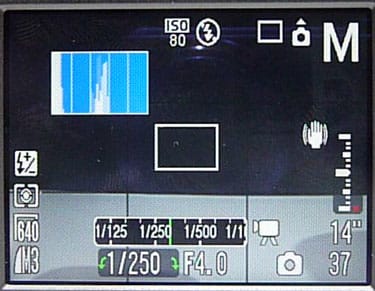

Shutter speed and Aperture can both be controlled in full manual mode.
In Shutter or Aperture Priority modes you can adjust the respective setting using the rotating dial around the 4-way without any other button presses or intervening menus. In full manual mode you can also use the dial to adjust these two items, switching between them using the Exposure Compensation button at the top right. One item we noticed was not easily accessible even in full manual were metering options, you'll still need to go into the Function Set menu to set that.
Focus
The Canon PowerShot SX10 IS has a focal length of 1.6 feet to infinity and offers both a standard Macro mode and Super Macro. One nice bonus that you don't often see on many consumer cameras is a manual focus. You can enable this by pressing up on the 4-way, then use the rotating dial to adjust the focus.
ISO
ISO can be adjusted by pressing left on the 4-way and then using the rotating dial to select form the ISO options. In Auto mode your only options are Auto and HI, while in manual mode you can choose from a range between 80-1600 ISO.
White Balance
White balance can be set in any of the manual modes via the Function Set menu, which is accessible by pressing the center select button on the 4-way. White balance is the first option in this menu and you can choose from Auto, Daylight, Cloudy, Tungsten, Fluorescent, Fluorescent H, Flash and Custom. The last setting allows you to use a white card to manually set the white balance.
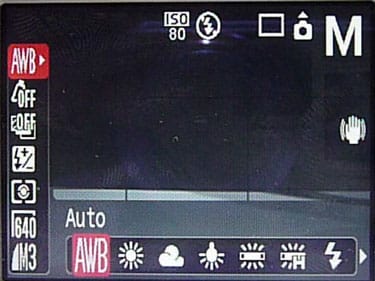
White balance settings can be found in the Functions Set menu.
Metering
The Function Set menu is also where you'll find metering options, about halfway down the menu. You can set metering to evaluative (balancing the exposure to best fit the full screen image), center-weighted or spot. Unlike the Canon G10 there's no dedicated button to quickly access metering options, and you can't switch between metering mode in addition to aperture and shutter speed when making quick adjustments in full manual mode.

Metering options can only be changed via the Function Set menu.
Shutter Speed
Shutter speed ranges from 15 to 1/3200, a reasonable range for a consumer point-and-shoot.
Aperture
The SX10 IS's aperture ranges from f/2.8 - f/8.0 when you are zoomed out completely. When zoomed in completely your aperture range gets slightly smaller at f/5.7 - f/8.0. This is a slightly smaller range than the SX5 IS, but you also have to consider that the SX10 IS ups the zoom ratio from 12x to a full 20x optical.
**Image Stabilization
**The Canon PowerShot SX10 IS offers optical image stabilization to keep shaky hands from ruining your shots, especially when you're using that 20x optical zoom.
Picture Quality / Size Options
The Canon PowerShot SX10 IS offers three quality options for still images: Normal, Fine and SuperFine. There are also six size options ranging from 3,648 x 2,736 all the way down to 640 x 480. A wide-screen mode is also available at 3,648 x 2,048, but unlike the Canon G10 there is no option to capture in RAW format.
Picture Effects Mode
You can apply photo effects to your images using My Colors from the Function Set menu. Your options are Vivid, Vivid Blue, Vivid Green, Vivid Red, Neutral, Sepia, Black & White, Positive Film, Lighter Skin Tone, Darker Skin Tone and Custom.
Conclusion
**
Conclusion**

The Canon PowerShot SX10 IS is a high-end consumer oriented camera that will appeal to amateur nature photographers or anyone else who's interested in getting close-ups without getting too close, thanks to an impressive 20x optical zoom lens. The extensive array of manual controls is also a big plus for anyone who's looking for more than a simple point-and-shoot. Reminiscent of an SLR in design, the SX10 IS is for those people who want some of the power of an SLR but don't want to deal with the complexity of changing lenses or the expense of buying them. The Canon PowerShot SX10 IS will retail for $499.99.
Specs / Ratings
**Specs Table
**{{manufacturer_specs_table}}{{raw_scores_table}}
Meet the tester

Alfredo Padilla
Editor
Alfredo Padilla is a valued contributor to the Reviewed.com family of sites.
Checking our work.
Our team is here for one purpose: to help you buy the best stuff and love what you own. Our writers, editors, and lab technicians obsess over the products we cover to make sure you're confident and satisfied. Have a different opinion about something we recommend? Email us and we'll compare notes.
Shoot us an email